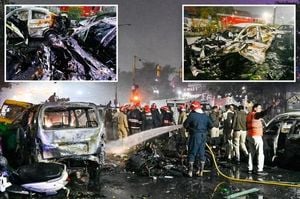When the remnants of Typhoon Halong barreled into the small coastal village of Kipnuk in Western Alaska on Sunday, October 12, 2025, it left devastation in its wake that few could have imagined. For the people of Kipnuk—many of whom are Alaska Native and have lived on this land for generations—the storm was more than just a meteorological event. It was a life-altering disaster that upended their homes, their sense of place, and their future.
Standing atop a battered boardwalk railing five days after the storm, 19-year-old Zacharias John surveyed the wreckage. "I don’t see Kipnuk anymore," he told visiting officials. "It’s not home." His words, reported by Anchorage Daily News, captured the heartbreak and disbelief felt by so many in the community. The destruction was everywhere: houses floated off their foundations, some coming to rest at odd angles on the banks of streams; other structures were flattened or simply vanished, leaving behind only scattered debris and memories.
John recounted the terrifying night the storm hit. As water surged into their home, he, his mother, and his younger siblings found themselves adrift, their house literally lifted from its foundation and carried by the floodwaters. They spent hours floating through the darkness until, by chance, the house became wedged against a boardwalk. "It’s a long time, a long time to be afraid," U.S. Senator Lisa Murkowski replied when John shared his ordeal with her during her visit to Kipnuk on Friday, October 17, 2025.
The numbers tell a sobering story. Kipnuk, which had a population of about 700 before the storm, is now largely in ruins. The chaos left homes, skiffs, and debris clustered in unexpected places, while sections of boardwalk twisted and buckled under the force of the waters. Four-wheelers and even a few muddy dogs could be seen amid the wreckage, darting across the broken boards as if searching for a familiar path. The havoc has been replaced by an eerie quiet, but the scars of the storm are everywhere.
The crisis in Kipnuk is not isolated. According to Alaska Public Media, the remnants of Typhoon Halong forced over a thousand people to evacuate from rural villages across Western Alaska in October 2025. Many of those forced to leave are Alaska Native people with deep, generational ties to the land—a connection now threatened by the storm’s devastation. The scale of the evacuation is unprecedented for the region, with hundreds of residents from Kipnuk and neighboring Kwigillingok airlifted to safety.
Authorities responded with what has been described as one of the most significant airlift operations in Alaska’s history. Over the course of Wednesday, October 15, and Thursday, October 16, the Alaska National Guard deployed planes and helicopters to ferry residents from the hardest-hit villages to Anchorage, nearly 500 miles away. The effort was coordinated by the Alaska National Guard and emergency management authorities, who worked around the clock to ensure the safety of those stranded by the floodwaters.
At an Alaska Army National Guard hangar in Bethel, evacuees waited their turn to board military transport aircraft. Among them was Luke Amik Jr., who spoke to Alaska Public Media about the loss he and his community endured. "Kipnuk is our hometown, and we’ve been living there all our life. Everything is lost now. All the memories … all the houses are gone." Amik’s words echo the grief and uncertainty felt by so many forced to leave behind the only home they’ve ever known.
Once in Anchorage, evacuees were taken to emergency shelters, where state officials encouraged them to register for the individual assistance program. Jeremy Zidek, a spokesperson for Alaska’s emergency operations, urged victims to sign up so they could receive vital support for housing, medical needs, and other expenses. "Emergency managers will be able to connect with survivors to provide them support for housing, medical needs and other expenses," Zidek explained, as reported by Alaska Public Media.
Back in Kipnuk, only about two dozen people remained as of Friday, October 17. Supplies of bottled water and food were running low, raising concerns about how long those left behind could hold out, especially with winter fast approaching. John, the young resident who chose to stay, hoped to help repair some wiring and downed utility poles, but he admitted, "Since winter’s coming, I don’t know how long we’ll be able to last here." The uncertainty is palpable, and the clock is ticking for those who remain.
The scale of the destruction became clear as U.S. Senator Lisa Murkowski and Governor Mike Dunleavy visited the area to assess the damage. Murkowski, accompanied by officials from the Alaska State Defense Force and the Alaska National Guard, spoke with survivors and surveyed the wreckage. "It’s hard to see homes that people lived in less than a week ago, homes with plants and puppies. People who have lived there for generations," she said. "And to now realize that there is no home to return to, that is a really hard reality." Before departing, Murkowski and her team even collected two dogs to deliver to a rescue organization and two Christmas cactuses, hoping they might be reunited with their owner—a small gesture of care amid the devastation.
Governor Dunleavy’s visit, alongside Alaska National Guard Maj. Gen. Torrence Saxe and Alaska Public Safety Commissioner Jim Cockrell, underscored the seriousness of the crisis. Both state and federal officials have promised to coordinate volunteer groups and marshal resources to help survivors begin the long process of rebuilding. But the challenges are immense: entire communities have been uprooted, and the path home remains uncertain for many.
For Alaska Native residents, the loss is more than physical. The land holds deep cultural and spiritual significance, and the prospect of not returning weighs heavily. As one observer noted, the evacuation has forced over a thousand people from the only land they’ve known, severing ties that span generations. The trauma of the storm is compounded by the fear that the old way of life may be gone for good.
Yet amid the heartbreak, there are glimmers of resilience. Survivors like John and Amik Jr. have shown remarkable courage in the face of disaster. The rapid and coordinated response by the Alaska National Guard, emergency managers, and countless volunteers reflects a community’s determination to help its own. And while the future is uncertain, the spirit of Kipnuk’s people endures—even in the face of unimaginable loss.
As winter looms and the work of recovery begins, the story of Kipnuk stands as a stark reminder of the vulnerability—and strength—of Alaska’s rural communities when disaster strikes.





